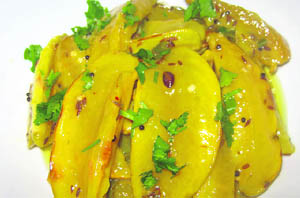|
Food Talk
Star performer
The sweet-and-sour kamrakh ki
sabzi is easy to cook and can fit the bill for the diet conscious
 You
have most likely seen the star fruit, as it is called in
English, on the khomcha (stool-kiosk) of a chat-seller. But,
tell us honestly, have you ever seen anyone eating it ever? We havenít.
This is what prompted us to ask our sabziwala when we spotted
it on his shelf, "Who buys this stuff." He surprised us by
informing that there are quite a few who relish it as a vegetable. You
have most likely seen the star fruit, as it is called in
English, on the khomcha (stool-kiosk) of a chat-seller. But,
tell us honestly, have you ever seen anyone eating it ever? We havenít.
This is what prompted us to ask our sabziwala when we spotted
it on his shelf, "Who buys this stuff." He surprised us by
informing that there are quite a few who relish it as a vegetable.
A friendly soul buying
the stuff was kind enough to share a Rajasthani recipe with us.
Denizens of the desert, as all of us know, have traditionally had to
cope with a severe scarcity of fresh green vegetables, and this has
made them experts at experimenting with unusual ingredients. They also
have a penchant for extra sour.
 A little research told
us that star fruit is widely used in South East Asia. Its strong acid
taste is much too sharp to enjoy uncooked but believe us, the sweet
and sour curry has unimaginable delights. They saw what is there in a
name; in this case, the Hindi name has seductions of its own. The word
derives from evocative Sanskrit Kamranga (Hues of Eros). Does
this indicate that the great-looking stuff has some hidden aphrodisiac
properties? A little research told
us that star fruit is widely used in South East Asia. Its strong acid
taste is much too sharp to enjoy uncooked but believe us, the sweet
and sour curry has unimaginable delights. They saw what is there in a
name; in this case, the Hindi name has seductions of its own. The word
derives from evocative Sanskrit Kamranga (Hues of Eros). Does
this indicate that the great-looking stuff has some hidden aphrodisiac
properties?
Or, in our old age, we
are clutching at straws! We recommend the recipe to our dear readers
full of innocence and only for the reason that it is easy to cook and
can fit the bill for the diet conscious. The unusual eye candy is a
bonus.
Kamarakh ki sabzi
 Ingredients Ingredients
Kamrakh 300 gm
Cumin seeds 1 tsp
Mustard oil 1 tbsp
Sugar to taste
Salt to taste
Method
Wash the kamrakh and
slice it about half and inch thick, or cut along the ridges
lengthwise. Heat oil till it reaches smoking point in a thick-bottomed
non-stick pan. Reduce heat and put in the cumin seeds. When these
begin to crackle, add the vegetables. Stir-fry for a minute. Add sugar
and salt. Reduce flame to low. Cover and let it simmer for about 10
minutes or till done to taste, stirring occasionally. Serve with a phulka
or rice.
|